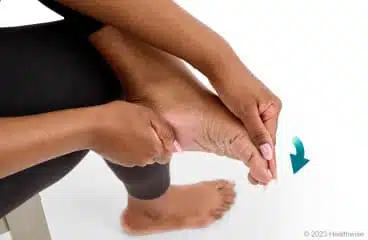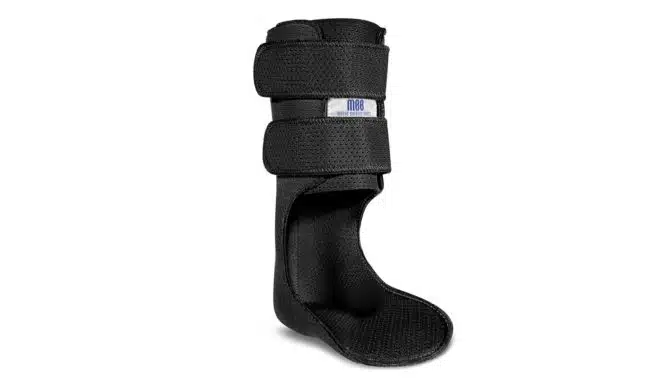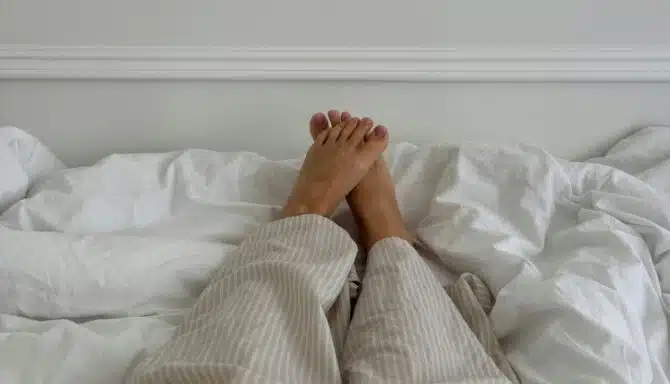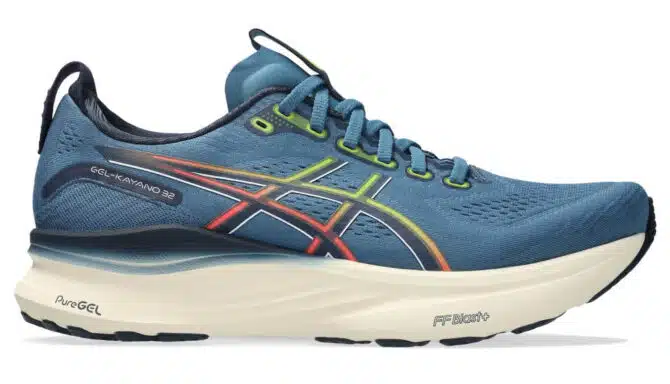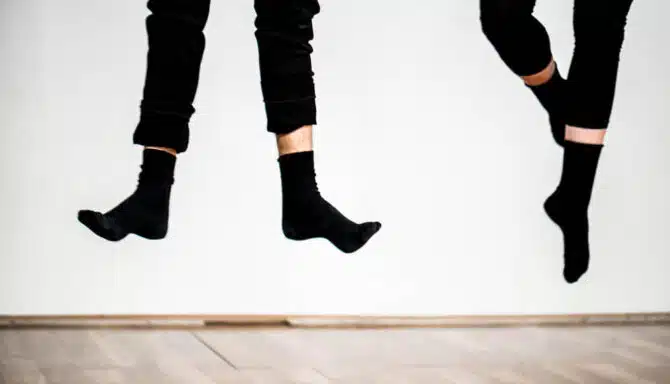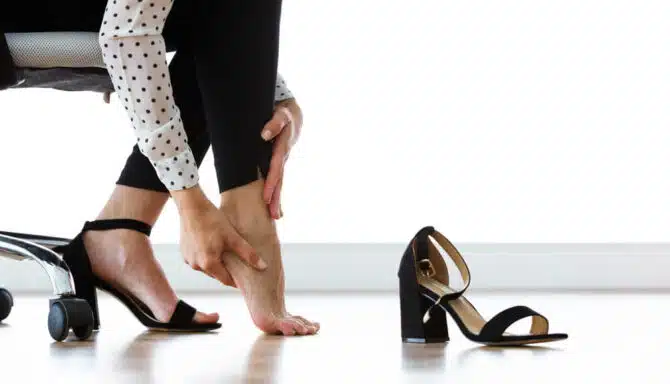October 30, 2025
Extensor tendonitis is a common foot condition that affects the tendons running along the top of your foot. These tendons connect your muscles to your toes and help lift your toes and foot during walking and other activities. When these tendons become inflamed or irritated, it can lead to pain and difficulty moving your foot comfortably.
What Is Extensor Tendonitis?
Extensor tendonitis refers to inflammation or irritation of the extensor tendons on the top of the foot. This condition often results from overuse, repetitive strain, or injury. People who are active in sports, wear tight footwear, or have certain foot structures may be more prone to developing extensor tendonitis.
Causes of Extensor Tendonitis
Overuse: Repetitive activities such as running, jumping, or walking long distances.
Improper Footwear: Shoes that are too tight or have insufficient space on the top can compress the tendons.
Foot Mechanics: Flat feet, high arches, or gait abnormalities can put extra strain on the tendons.
Injury: Trauma or sudden impact to the foot.
Underlying Conditions: Arthritis or inflammatory diseases may contribute to tendon irritation.
Symptoms of Extensor Tendonitis
Pain and tenderness on the top of the foot, especially over the affected tendon.
Swelling or redness along the top of the foot.
Difficulty lifting the toes or foot.
Pain worsens with activity and improves with rest.
Occasionally, a burning or tingling sensation.
Treatment Options
Rest and Activity Modification
Avoid activities that aggravate the pain and allow the tendon to heal.
Proper Footwear
Wear shoes with adequate space in the toe box and good support to reduce pressure on the top of the foot.
Ice Therapy
Apply ice packs to reduce inflammation and pain.
Physical Therapy
Stretching and strengthening exercises can improve tendon flexibility and foot mechanics.
Orthotics
Custom orthotics may help correct biomechanical issues that are causing excess strain on the extensor tendon and muscles on top of the foot.
Medication
Non-steroidal anti-inflammatory drugs (NSAIDs) can reduce pain and inflammation.
When to See a Specialist
If pain persists beyond a few weeks or worsens, consult a chiropodist or foot specialist for a biomechanical assessment and personalized treatment plan.
July 10, 2025
What is an Ankle Foot Orthotic (AFO)?
An ankle foot orthotic (AFO) is a medical-grade brace that supports the foot and ankle. It often extends partway up the calf. Unlike regular foot orthotics—which fit inside shoes to support the arch and heel. AFOs offer external stabilization of both the foot and ankle joints.
AFOs are commonly made of lightweight plastic or carbon fiber and may be custom-made or prefabricated. They assist walking, correct alignment, reduce pain, and help prevent further injury.
Who Needs an AFO?
Image from https://braceworks.ca/ and the Washington Post
AFO's received mainstream attention a few years ago when NFL quarterback Alex Smith returned to the football field after a catastrophic leg injury. The key to his return: an ankle foot orthotic. Due to a post-surgical infection, the nerve that helps flex the right foot was severed. This meant he couldn't lift his foot. So he got an AFO to help and made a brief comeback (with the help of an extensive rehab team).
So who exactly needs an AFO? Since AFOs are heftier than regular orthotics, they're typically recommended for patients with more complex conditions than those addressed by traditional foot orthotics. You might benefit from an AFO brace if you have:
Foot drop (difficulty lifting the front of the foot)
Cerebral palsy or neuromuscular disorders
Stroke-related gait issues
Multiple sclerosis (MS)
Post-surgical ankle instability
Tendon or ligament injuries
Severe arthritis affecting ankle mechanics
Ankle foot orthotics are most commonly indicated for neuromuscular disorders and foot drop.
AFOs v Regular Orthotics: What's the Difference?
FeatureRegular OrthoticsAnkle Foot Orthotics (AFOs)ScopeFoot support onlyFoot and ankle supportPlacementInside the shoe (underneath the foot)Worn underneath and around the foot, and around the ankleConditions TreatedArch pain, plantar fasciitis, overpronation, high arches, other biomechanical irregularitiesNeurological and structural gait disorders, severe instabilityCustomizationOften custom-fit or prefabOften custom-molded to leg shapeMobility SupportModerateHigh—can aid in walking and balance
While regular orthotics focus on redistributing pressure and correcting foot mechanics inside the shoe, AFOs provide external control for more complex biomechanical or neurological issues. Think of it as the difference between cushioning a sore spot and physically guiding your limb’s motion.
How Are AFOs Made and Fitted?
https://www.youtube.com/watch?v=nA_QklH7AWY
AFOs are usually prescribed by a foot specialist or chiropodist after a full assessment. The process may include:
Biomechanical Assessment
Gait analysis
Casting or 3D scanning
Custom fabrication
Fitting and adjustments
Some patients may only need short-term use post-injury or surgery, while others may rely on AFOs for long-term mobility support.
Final Thoughts
If you’ve been told you need more than just arch support or if your walking pattern has changed due to injury or illness, an ankle foot orthotic could be a game-changer. At our clinic, we assess your full biomechanics and work with you to find the right support—whether that’s a custom orthotic, AFO, or a combination of both.
June 12, 2025
When we talk about healthy habits, we often focus on nutrition, mental health, or overall fitness. But what about your feet? These often-overlooked heroes carry you through life and they deserve some attention, too.
Incorporating a few gentle foot mobility drills into your morning routine can help improve flexibility, reduce stiffness, and set you up for a pain-free day. Let’s explore a few simple daily foot exercises that support longevity and mobility, all in under 10 minutes.
Why Morning Foot Rituals Matter
After a night of rest, it’s normal for your feet to feel stiff or tight. That’s because circulation slows down when we sleep, and our muscles and joints aren’t being used. A quick morning routine for foot health helps:
Improve blood flow
Gently wake up foot muscles
Prevent long-term issues like plantar fasciitis or joint stiffness
Support better balance and stability throughout the day
Plus, it feels great — and your feet will thank you!
Your 5-Minute Morning Routine for Foot Health
These beginner-friendly exercises can be done from your bed, the bathroom counter, or even while you’re waiting for your coffee to brew.
1. Toe Spreads (1 minute)
https://youtube.com/shorts/gOwgyrmU6hM?feature=shared
Sit or stand comfortably. Spread your toes apart as wide as you can, then release. Repeat 10–15 times.Why it helps: Improves foot strength and activates the smaller intrinsic foot muscles that support balance.
2. Ankle Circles (1 minute per foot)
https://youtu.be/qaatVpZy2ek?feature=shared
Lift one foot off the ground and gently rotate your ankle clockwise 10 times, then counter-clockwise 10 times. Switch feet.Why it helps: Promotes circulation and joint mobility to counteract morning stiffness.
3. Towel Curls (1–2 minutes)
https://youtu.be/toqnSys_JRw?feature=shared
Place a small towel on the floor and try to scrunch it toward you using just your toes.Why it helps: Strengthens the arches and enhances coordination in the foot muscles.
4. Calf Stretch with Wall or Step (1–2 minutes)
https://youtu.be/utLavyPDnqI?feature=shared
Stand with your hands on a wall or place your toes on a step while your heel stays on the ground. Lean forward until you feel a stretch in your calf and Achilles tendon. Hold for 20–30 seconds per leg.Why it helps: Loosens up the back of the leg and heel — essential for preventing plantar fasciitis and Achilles tendonitis.
Bonus: Gentle Foot Massage
https://youtu.be/BwhGFoHDkUI?feature=shared
Before putting on your socks or shoes, use your thumbs or a massage ball to roll out the soles of your feet. Focus on tight spots in the arch and heel. Just 1–2 minutes can make a big difference.
Foot Mobility Drills = Long-Term Foot Wellness
Incorporating these foot mobility drills into your morning can support not just your feet, but your entire body. Improved foot function leads to better posture, less knee and hip pain, and more stability with every step you take.
And remember — consistency is key. Like any good habit, the benefits of daily foot exercises build up over time.
Feature Photo by Aljona Ovtšinnikova
April 24, 2025
If you’re dealing with flat feet and overpronation, or sometimes other foot issues, finding the best stability running shoes can provide the support and comfort you need. These shoes are designed to help keep your feet properly aligned and reduce strain, making them perfect for running or everyday wear. In this guide, we’ll help you find the right pair and keep you moving with a little more peace of mind.
What are Stability Shoes?
https://www.youtube.com/shorts/TnDaLrqYTac
To understand what stability shoes are, it’s important to explain the different foot types and the corresponding, suitable shoes that accommodate each type. Foot types are characterized by how pronounced the arch is, as well as any associated gait abnormalities (walking patterns):
Flat feet: When you have a minimal or non-existent foot arch, or when your footprint looks like a complete foot. The foot rolls excessively inward when it’s in motion (overpronation). It is often linked to the development of plantar fasciitis.
High arches: When your arch is very pronounced and you see very little of your footprint. Sometimes associated with underpronation, or when the foot rolls excessively outward when it’s in motion.
Normal arch: When your arch is about halfway “filled” when you look at it from a footprint perspective. There are generally no issues with overpronation or underpronation.
Why Stability Shoes?
Think of stability shoes as running shoes for flat feet. They are specifically engineered to help people who overpronate, providing enhanced support and alignment during movement. They are more rigid, rather than flexible, to ensure the foot stays securely in place when it propels forward. That said, thanks to technological innovation, many stability running shoes on the market offer the necessary correction without feeling restrictive.
More specifically, unlike neutral running shoes (which tend to be more flexible and are suited for those with a normal gait or high arches), stability shoes guide the foot into a more neutral position. This is achieved through features like firmer midsoles and supportive arch structures that counteract the inward rolling motion characteristic of overpronation. By doing so, stability shoes help distribute pressure more evenly across the foot, reducing strain on muscles and ligaments.
This design not only improves comfort during activities like walking or running; it also plays a crucial role in preventing injuries commonly associated with overpronation, such as plantar fasciitis and shin splints.
If you have severe overpronation, motion control shoes offer an even higher level of support. These shoes are constructed with stiffer materials and additional structural components, such as reinforced heel counters and medial posts, to limit excessive foot movement.
While some motion control shoes may feel heavy, they provide maximum control, ensuring the foot maintains proper alignment throughout the gait cycle. This level of control is particularly beneficial for those who require substantial correction to prevent overuse injuries. Motion control shoes can significantly reduce the risk of pronation-related injuries in recreational runners and can be an effective injury prevention strategies.
How Do Stability Shoes Prevent Foot Pain?
Stability shoes help prevent foot pain by offering targeted support where your feet need it most—especially in the arch and heel areas. When your foot rolls too far inward, it puts extra strain on the muscles, tendons, and ligaments that work to keep your stride in check. Over time, this can lead to discomfort or injuries like plantar fasciitis, shin splints, or achy knees. Stability shoes are designed to keep that motion in check, gently guiding the foot to move in a more efficient and aligned way. This takes the pressure off the wrong areas and helps absorb shock more evenly across your foot.
Another key way stability shoes help reduce foot pain is by minimizing the stress placed on your body with every step. Features like firm medial support and structured cushioning help maintain better posture and balance, especially during long walks or runs. That added support means your feet aren’t constantly working overtime to stabilize themselves, which can help you stay active longer without feeling sore. At the end of a long day, your feet will thank you!
The Best Stability Running Shoes
Where do you start when you want to find the right pair? Luckily, we’re going to talk about some of the best options. Some of these are available at our Toronto foot clinic, Feet First Clinic, and come highly recommended by chiropodists and podiatrists. You can always call or visit us to determine what high quality footwear we have in stock at any given time.
ASICS Gel-Kayano 32
The ASICS Gel-Kayano 32 is a go-to for runners seeking plush support and a smooth ride. This latest version keeps the high-level stability the Kayano line is known for, while dialing up the comfort with soft cushioning and a breathable upper. It’s ideal for daily training or long runs when your feet need some extra TLC.
If you're browsing for the top running shoes for stability, the Gel-Kayano 32 should be on your radar. It contains ASICS' 4D Guidance technology. This features a "pod" that acts as a medial post to control the movement of the foot and ankle and prevent overpronation. The medial post is made of a responsive material that will respond to your foot's motion and prevent over-correction. In addition, unlike other stability models with a stacked heel, the Gel-Kayano is structured to "cradle" the foot. This gives all cushioned benefits of a stacked heel and mid-rocker sole, without compromising stability and balance.
Whether you're logging serious miles or just want a reliable everyday trainer, this one's a solid pick.
Saucony Hurricane 24
The Saucony Hurricane 24 is a max-cushion stability shoe built for comfort and support. It features a plush PWRRUN PB midsole and a wide base that keeps you steady, even on longer runs. The shoe is a bit on the heavier side compared to other shoes, but it delivers a smooth, stable ride that's easy on the legs.
For those looking for Stability running shoes for overpronation, the Hurricane 24 is a standout option. It provides excellent support without feeling too rigid, making it great for runners who need a bit more structure. Just keep in mind that it's not the best choice for speedwork due to its weight.
ASICS GT-2000
The ASICS GT-2000 is a reliable stability shoe that offers a balanced blend of cushioning and support. It's designed for runners who need moderate stability without sacrificing comfort. The shoe provides a smooth transition from heel to toe, making it suitable for daily training.
While it may not have the plushness of the Kayano, the GT-2000 is a versatile option for runners seeking a more responsive feel. It's a solid choice for those who need an athletic stability running shoe that doesn't feel too bulky.
Brooks Glycerin GTS
The Brooks Glycerin GTS is a max-cushion stability shoe that combines softness with support. It features Brooks' GuideRails technology, which helps keep your stride aligned without being intrusive. The shoe offers a plush ride that's perfect for long runs or recovery days.
If you're looking for a stability shoe that doesn't skimp on comfort, the Glycerin GTS is worth considering. It's designed to provide a smooth, cushioned experience while still offering the support needed for overpronators. Just be aware that it's more suited for easy runs rather than speed sessions.
https://www.youtube.com/shorts/mxrb9Qihtiw
February 27, 2025
Dealing with high arches and back pain can be a challenging combination, as the two are more connected than they seem. Understanding how high arches contribute to back pain is key to finding effective treatments and preventing further issues. Whether you’re dealing with foot pain, back pain, or posture problems, addressing high arches can significantly improve overall comfort and protect the rest of your body—especially your back.
What are High Arches?
https://www.youtube.com/shorts/osC-UmBtgNk
High arches (or cavus foot or pes cavus) is a condition where the foot has an abnormally pronounced arch (as opposed to a flat foot or a normal arch).
Having high arches can be due to simple genetics, inheriting structural abnormalities in the foot from your parents. They can also be caused by several neuromuscular disorders, which are conditions (ranging from mild to severe) that cause dysfunction or muscle weakness and leave certain muscles inactive.
High arches generally develop during or after childhood when the flat feet most children have start to take shape and the foot arch forms. In some cases, idiopathic pes cavus occurs without a known cause (like genetics or neuromuscular disorders), and is just a case of simple variations in bone and ligament structure.
A pronounced foot arch is usually quite discrete, aesthetically, and isn’t a serious condition. However, high arches are a common cause of foot pain and discomfort. High arches put extra pressure on the heel and ball of the foot, affecting normal pressure distribution and making it harder to absorb shock properly. This can lead to heel pain (plantar fasciitis— which is also commonly linked to flat feet feet), arch pain, and more, as the muscles and ligaments supporting the foot work overtime to stabilize each step, leading to inflammation or strain.
High arches often cause the foot to roll outward, a motion known as supination. This can place extra stress on the ankles and knees, further disrupting alignment and increasing the risk of injuries like sprains and shin splints.
It’s important to schedule an assessment with a foot specialist, like a podiatrist or chiropodist, if having high arches affects your daily life.
The Connection Between High Arches and Back Pain
https://www.youtube.com/shorts/7m3SQ5dXaeg
A pronounced arch can also lead to back pain. But how do high arches affect the back when the two areas seem relatively far apart?
The answer lies in how the body stays balanced. Many foot problems, not just high arches, often cause back pain—along with knee, leg, and ankle discomfort—because the feet serve as the body's foundation (carrying your weight) and closest connection to the ground. When that foundation is misaligned and overworked, the entire body has to compensate, leading to strain in other areas. Simply put, everything is connected, and the feet play a crucial role in maintaining functionality throughout our body’s kinetic connection!
When it comes to the back, pain and poor posture often coexist. As we know, when the arches are too high, they can throw off the body's natural alignment, affecting the way you stand and walk. Uneven weight distribution forces the lower body to compensate, which can lead to foot pain and posture issues over time. The strain on the feet may cause the ankles to supinate, shifting stress to the knees and hips. This misalignment can travel up the spine, making it harder to maintain proper posture and increasing the risk of chronic discomfort.
Without proper shock absorption, the impact of each step travels up through the joints, leading to tension in the lower back and shoulders. Over time, these small imbalances can create lasting posture problems, making everyday movements more difficult.
Treating High Arches and High Arch-Related Back Pain
When you treat high arches, you’re also preventing any potential back pain that may occur further down the road. But if you already struggle with high-arch related back pain, you can still focus on treatment methods that simultaneously target both issues.
Video Gait Analysis
https://www.youtube.com/shorts/Rhuga6vLdc0
This is when a Chiropodist or Podiatrist assesses your walking patterns (also known as your gait) using video gait analysis equipment. It can give foot care professionals insight into the potential damage your high arches could cause, so they can recommend preventative treatments.
Custom Orthotics and Insoles
A Podiatrist or Chiropodist can prescribe custom orthotics that you can wear inside your shoes. They will provide much-needed arch support, distribute weight evenly, and reduce strain on the feet and spine. Another option is over-the-counter Superfeet insoles, with the Superfeet Green: All Purpose High Arch being a good choice to ask your foot specialist about.
Supportive Footwear
Look for shoes with good arch support, cushioning, and shock absorption to minimize impact on joints. People with high arches should wear shoes with flexible midsoles or rocker soles to improve movement and reduce strain. Cushioning running shoes with shock absorption help counteract supination, ensuring even pressure distribution and healthy biomechanics. Avoid high heels, rigid soles, and unsupportive flats, as they can increase discomfort.
Read more about the link between footwear and back pain.
Stretching and Strengthening Exercises
https://www.youtube.com/shorts/-EeyHTdkrEs
Targeting the feet, calves, and lower back can improve flexibility and stability, reducing pain. Some of the best include towel stretches (where you place a towel under your foot arch and pull towards you), seated toe pulls (pulling the top of your foot towards you - see above!), ankle circles and massage ball rolls (rolling your foot arch on a therapeutic massage ball). You can read more about them, including how to perform them, here. You can also try clamshells on an exercise mat with your ankles together (this will also help soothe hip pain. See below for a demonstration!
https://www.youtube.com/shorts/ZODK0Q4zOws
January 9, 2025
Living with high arches can be a challenge, but if you pay attention to your foot health, you can manage them effectively. Let’s explore what high arches are, their impact, and our top 4 tips for living with high arches.
What Are High Arches?
https://www.youtube.com/shorts/13rmyA18ZzY
High arches (pes cavus) is a condition where one has - you guessed it - abnormally high foot arches. They are essentially the opposite of flat feet, which are characterized by having a minimal or non-existent arch. High arches may be hereditary or caused by neurological disorders such as Charcot-Marie-Tooth disease.
From a biomechanical perspective, the raised arch reduces the surface area in contact with the ground, which can result in an uneven distribution of weight across the foot. High arches often place excessive pressure on the ball and heel of the foot, leading to discomfort, instability, potential injuries and chronic foot conditions. High arches also impairs shock absorption, which causes progressive wear-and-tear on the joints over time.
Side effects of high arches include foot pain, issues like calluses and hammertoes, and an increased risk of ankle sprains. Individuals can also develop conditions like plantar fasciitis (this can also frequently occur in people with flat feet), or Achilles tendonitis due to the strain placed on the muscles and ligaments. The lack of shock absorption can also reverberate up the body and lead to joint disorders like arthritis.
High arches are associated with supination, also called underpronation, a condition where the foot rolls outward during movement. This gait pattern places additional stress on the outer edges of the foot and ankle, leading to instability and overuse injuries. Consequently, individuals with high arches should pay close attention to their walking or running patterns to prevent long-term complications.
High arches can also lead to changes in posture and gait. This, combined with the lack of shock absorption, may result in secondary issues such as knee, hip, or back pain over time.
Tips for Living with High Arches
https://www.youtube.com/shorts/2et0ZUSx4OM
Living with high arches requires thoughtful adjustments to your daily routine and habits. Here are some ways to keep your feet comfortable and supported:
1. Choose the Right Footwear
Proper footwear is essential for managing high arches. Opt for shoes with ample shock absorption, arch support and cushioning. Shoes with flexible midsoles or rocker soles can also be very helpful: People with high arches tend to have rigidity in the toes and ankles due to joint wear-and-tear, which means the toes and ankles do not flex as much as it should during the gait cycle. A flexible midsole and rocker sole counteracts this and make movement easier. Likewise, people with high arches should avoid high heels, rigid soles, and unsupportive flats, which can exacerbate discomfort.
Due to supination, people should look for cushioning running shoes. These provide balanced cushioning and plenty of shock absorption and flexibility to support the foot’s natural motion and healthy biomechanics. This design helps distribute pressure evenly, enhances comfort, and reduces the risk of injury.
2. Wear Custom Orthotics
Custom orthotics are a valuable tool for redistributing pressure evenly across the foot. You can work with a specialist, like a podiatrist or chiropodist, at a foot clinic to create orthotics tailored to your specific needs.
Scientifically, custom orthotics help correct abnormal biomechanics, such as excessive supination, by stabilizing the foot and encouraging a more neutral gait. They can also provide added cushioning to reduce the impact of your stride on your joints. Over time, this can alleviate pain, reduce fatigue, and prevent the development of secondary issues in the knees, hips, or lower back.
3. Maintain a High Arch Foot Care Routine
Foot baths and massages can soothe foot pain, relax the muscles in your feet and boost blood circulation.
Soak your feet in warm water with Epsom salts, or foot bath products from reputable companies like Gehwol, to alleviate tension. Gehwol products, such as their Herbal Foot Bath, are available to buy at our Toronto foot clinic, Feet First Clinic!
Gently massage the arch, heel, and toes to improve circulation and relieve tightness. Read this article to learn how to give yourself a foot massage from home.
4. Try Stretching and Strengthening Exercises
Foot stretches and exercises play a crucial role in managing high arches by improving flexibility, reducing muscle tightness, and promoting better blood circulation in the feet. High arches can lead to stiffness and imbalances in the tendons and muscles, increasing the risk of discomfort and injury. Over time, these stretches can support better alignment and strengthen the foot's ability to handle daily stress, making them an essential part of high arch foot care.
Here are some simple routines you can try today!
Toe Flex and Raise: While standing, plant your toes and lift your heels off the ground. Hold for 15-30 seconds and repeat 5 times.
Seated Towel Stretch: Loop a towel around your foot and gently pull it toward you, holding for 15-30 seconds.
Pen Pick-ups: Stay seated. Then, lay three pens, or similarly shaped objects, in front of you–spaced apart evenly. Using your toes, pick up each pen and place it in a bowl.
Seated Toe Pulls: Sit on a chair and cross one ankle over the opposite knee. Grab the top of your foot and gently pull it toward your body until you feel a stretch on the top of your foot. Hold for 15-30 seconds and repeat 2-3 times per foot.
https://www.youtube.com/shorts/-EeyHTdkrEs
Additional High Arch Pain Relief Tips
More practical approaches for high arch pain relief include:
Ice Therapy: Apply an ice pack to sore areas for 15-20 minutes to reduce inflammation and soothe discomfort. If your feet are particularly painful, take this one step further by practicing the RICE method (Rest, Ice, Compression and Elevation).
Supportive Inserts: Use over-the-counter insoles with firm arch support. A good choice for high arches is the Superfeet Green or the Superfeet Run Cushion High Arch insoles. However, talk to a podiatrist or chiropodist about if you need more customized support from orthotics.
Medication: Nonsteroidal anti-inflammatory drugs (NSAIDs) may help manage pain.
Seek Professional Help: Visit a podiatrist or chiropodist for a biomechanical assessment to determine how prominent your high arches are, how they are affecting your body, and any contributing biomechanical factors. These foot specialists can also fit you for custom orthotics, provide shoe recommendations and curate a full treatment plan.
When to See a Specialist For High Arches
If high arches are causing persistent discomfort or limiting your mobility, it’s essential to seek professional advice. As we mentioned, visiting a foot clinic ensures access to personalized treatment plans. Consulting a foot specialist is especially important if you notice:
Increased frequency of ankle instability or sprains.
Development of deformities like hammertoes, claw toes, or bunions.
Chronic pain that makes simple activities like walking increasingly difficult.
A foot specialist can recommend the appropriate treatments, depending on the severity of your condition. They may also suggest physical therapy to improve balance, coordination, and overall foot function.
Regular check-ups and assessments with a podiatrist or chiropodist can prevent seemingly minor issues from becoming major concerns. Don’t hesitate to seek their expertise!
https://www.youtube.com/shorts/XZUfVhny5pY
